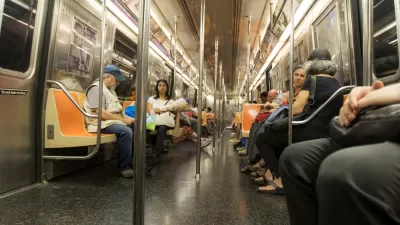When it comes to transit, it's quality, not just quantity.

A post on the TransitCenter website uses data gathered with the AllTransit tool "to analyze who exactly benefits from good transit…"
To describe how AllTransit enabled the analysis, the post first explains that the tool "can distinguish between the transit lines that create communities of regular riders and the infrequent bus and rail service that passes for transit in too many places" when it assigns a Performance Score to "almost any address in the country."
As for the findings of the analysis, the post explains that a surprising amount of Americans live near transit in the 25 largest U.S. cities, plus three more (Atlanta, Cleveland, and Miami):
In every one of the cities analyzed, a majority of the population lives within walking distance of a bus or rail stop—even Jacksonville, Florida, which at 875 square miles is larger than 27 sovereign countries. In 13 of the 28 cities, more than 90 percent of people live within walking distance of transit.
Yet before celebrating too much over these surprisingly positive marks, AllTransit also determines that "most of the transit described above is of poor quality—that is to say, it isn’t frequent enough to be a reliable option transportation option." The post offers a infographics and clear explanations to make critical points about the quality of public transit options in U.S. cities.
FULL STORY: Who Lives Near Frequent Transit?

Coming Soon to Ohio: The Largest Agrivoltaic Farm in the US
The ambitious 6,000-acre project will combine an 800-watt solar farm with crop and livestock production.

Pennsylvania Mall Conversion Bill Passes House
If passed, the bill would promote the adaptive reuse of defunct commercial buildings.

U.S. Supreme Court: California's Impact Fees May Violate Takings Clause
A California property owner took El Dorado County to state court after paying a traffic impact fee he felt was exorbitant. He lost in trial court, appellate court, and the California Supreme Court denied review. Then the U.S. Supreme Court acted.

Divvy Introduces E-Bike Charging Docks
New, circular docks let e-bikes charge at stations, eliminating the need for frequent battery swaps.

How Freeway Projects Impact Climate Resilience
In addition to displacement and public health impacts, highway expansions can also make communities less resilient to flooding and other climate-related disasters.

California Grid Runs on 100% Renewable Energy for Over 9 Hours
The state’s energy grid was entirely powered by clean energy for some portion of the day on 37 out of the last 45 days.
City of Costa Mesa
Licking County
Barrett Planning Group LLC
HUD's Office of Policy Development and Research
Mpact Transit + Community
HUD's Office of Policy Development and Research
Tufts University, Department of Urban and Environmental Policy & Planning
City of Universal City TX
ULI Northwest Arkansas
Urban Design for Planners 1: Software Tools
This six-course series explores essential urban design concepts using open source software and equips planners with the tools they need to participate fully in the urban design process.
Planning for Universal Design
Learn the tools for implementing Universal Design in planning regulations.


























